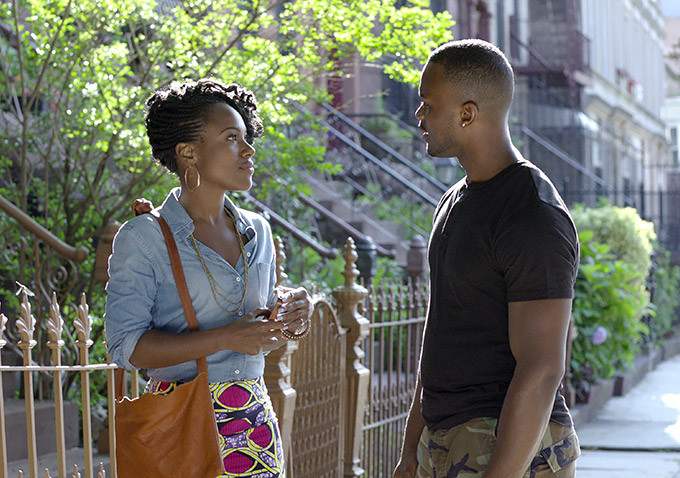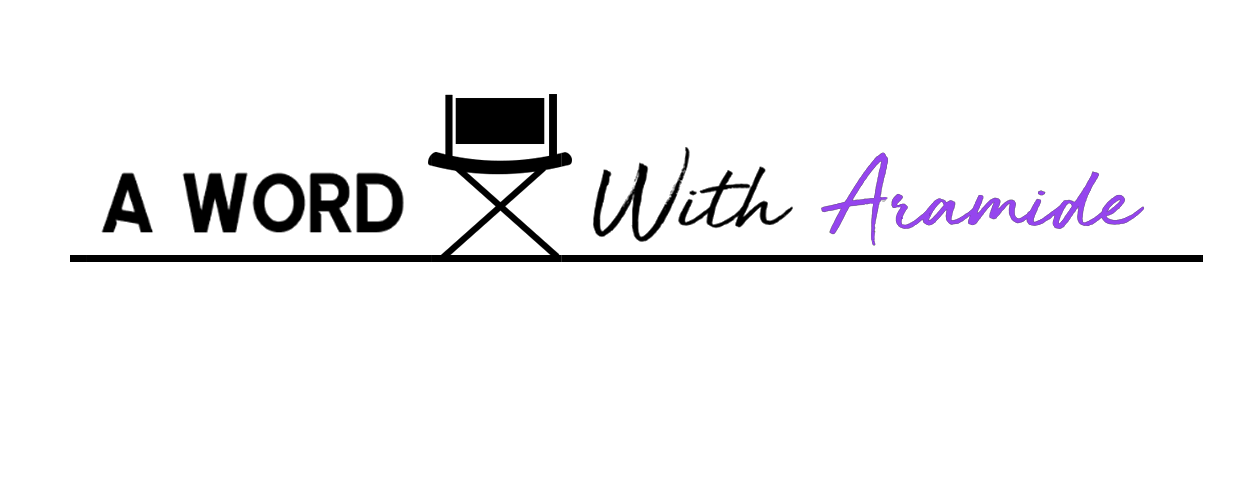At a time when we need it most, Black love is finally coming into focus on-screen.
Black Romance In Film Makes A Glorious Return On The Set Of 'The Photograph'
Love and romance are integral parts of the human experience. However, romantic dramas in cinema starring Black people have been few and far between. Some of the most beloved have been Love Jones, The Best Man and Love & Basketball. Also, recent projects like Beyond the Lights, Moonlight and If Beale Street Could Talk have shown Black love. However, there have been limited films that solely focus on love and relationships between young Black people in the 21st century. In her New York City-based romantic drama, The Photograph, writer and director Stella Meghie is putting the spotlight on Black love stories.
The Photograph follows Mae Morton (Issa Rae), a museum curator grappling with the death of her estranged mother, a famed photographer. After uncovering a forgotten photograph in her late mother's safety deposit box, Mae embarks on a quest to unpack who her mother truly was. Her journey connects with journalist Michael Block (Lakeith Stanfield), who is working on his own story about Mae's mom.
"I was 16 watching Love Jones on repeat," Meghie explained when Shadow And Act visited The Photograph set in New York City. "It was an adult, very sexy, intellectual, sophisticated kind of love. That film shaped me a lot. Love & Basketball was a big thing for me. Gina Prince-Bythewood is a definite inspiration. Hav Plenty as well."
The Photograph is a story that the Canadian-born director has been wanting to create for years. "I talked to Will [Packer] about a romantic drama like five years ago," she revealed. "I ended up doing my first film Jean of the Joneses and then Everything, Everything. However, I wanted to come back to this script. I finally ended up writing it a few years later after we spoke about it."
Continue reading at Shadow and Act.
Image: Universal Pictures.
Why We’re Still Falling For 'Love & Basketball' 19 Years Later
Black movies came thundering through Hollywood in the 1990s. Films like Boyz n the Hoodand Menace II Society gave the world a glimpse into inner city African-American life. Meanwhile, movies like Waiting to Exhale and Soul Food gave audiences a window into the lives of professional black women. Despite this new wave of Black cinema, romance films with African-American casts had not yet made their appearance.
Love Jones and The Best Man broke the mold by showcasing the trials and tribulations of black love. However, when it came to putting the first inklings of love and sensuality on screen outside of dangerous environments, young black people —teens, in particular, had to look toward mainstream films like She’s All That or 10 Things I Hate About You for some sort of connection. Black characters may have been sprinkled throughout these films —but they certainly weren’t the central focus.
In 2000, Gina Prince-Bythewood shattered the standard for romance, black love, and sensuality in cinema with her acclaimed drama, Love & Basketball. Set in the early ’80s and moving into the ‘90s, Monica (Sanaa Lathan) and Quincy’s (Omar Epps) romance begins at age 11 when Monica and her family move next door to Quincy’s. Rambunctious and feisty pre-teens— the pair have an instant rivalry and mutual respect because of their shared love of basketball.
From the moment the film opens with Al Green’s “Love and Happiness” spinning in the distance, these kids speak the same language. As they step into their teen years, Monica and Quincy’s admiration for one another grows—as does something a bit more sensual that begins to burn under the surface. However, basketball, the politics of gender, and the perils of adulthood start to crack the foundation of their love and friendship.
The best romance films speak to our souls because our investment and the love we have for the characters tug at our hearts, and awakens some common connection we have in our own lives. Monica and Quincy’s story builds over four quarters (like a basketball game) instead of a meet-cute, confrontation, and resolution told over three acts. Instead, writer/director Prince-Bythewood takes the time to reveal the characters in all of their beauty, humanity, desires, and internal conflicts.
By the Second Quarter at age 18, both Quincy and Monica are formable basketball players with vastly different styles on the court. While Quincy seems to float across the hardwood flooring, Monica is vicious in her defense and offense. As she dribbles down the court, the audience is privy to her inner-dialogue, and her desperate desire to prove herself as one of the best players out there, regardless of gender.
Historically, women have never been allowed the full emotional capacity for sportsmanship. As a result, Monica’s constantly attitude gets her in trouble during games, and further alienates her from her traditionally-minded mother, Camille (Alfre Woodard).
Quincy also has a lot to live up to. His father Zeke (Dennis Haysbert) is a pro-basketball player whom he idolizes. As Quincy matures — the facade that Zeke has built around himself as a father and a husband begins to unravel, threatening to break Quincy’s spirit and perception of self. Though Quincy is king of their high school and Monica stands on the outskirts—their mutual passion has kept them connected over the years. Through Prince-Bythewood’s lens, they are constantly orbiting around each other. At night, instead of listening to his parents fight, Quincy crawls out of his bedroom window and into Monica’s where she offers him a pillow, blanket, and space on her floor. His secrets remain safe with her. Also, it’s Quincy that Monica trusts when it comes to opening her recruitment letter from the University of Southern California (USC).
In the age of Barry Jenkins’ If Beale Street Could Talk, it seems stunning that sex and sensuality amongst black people was almost non-existent on screen up until the mid-’90s. Love & Basketball helped usher in a new era of black intimacy and desirability in film. For black women, regardless of socioeconomic background or religion –many of us been grounded in a tradition of silence when it comes to sex as a way to undermine stereotypes of hypersexuality. Black women have often been taught to suppress their sexuality, or we’ve been shamed into silence about physical needs and desires. It’s a mold that has slowly been chipped away in the last thirty years or so in popular culture.
In Love & Basketball, Prince-Bythewood presents sex as a celebratory act —a moment to be enjoyed. In Quincy’s arms —Monica is not merely desired, she’s also protected, and she never needs to be put on display. Sex scenes —especially when they are meant to capture a first-time encounter aren’t often given the care and consideration that should be expected of the experience. With Maxwell’s “This Woman’s Work” in the background Prince-Bythewood presents the beauty and candor of sex (with the visual use of a condom and verbal consent). Though we see Quincy’s reactions to Monica and her body — his appreciation, and reverence of her is evident —the experience is presented through her perspective. She isn’t an object to be ogled or placed on display. Instead, because the camera stays on her face, the audience is privy to her emotional state and the romance of the encounter.
Continue reading at The Spool.
Sundance Review: 'How to Tell You’re a Douchebag' Is a Black Rom-Com for the 21st Century
 It was films like “Nothing But A Man,” “Love Jones” and “Love & Basketball” that made me fall in love with cinema. As a millennial, in the ‘90s there was “Love Jones”, a narrative of passion set against Chicago’s urban backdrop. Hopeless romantics and cynics alike watched as Nina Mosely and Darius Lovehall, desperately tried to figure out that thing called love. In the past decade (except for Gina Prince-Bythewood‘s “Beyond the Lights”) Black romance in film has fallen by the wayside in favor of buddy comedies or ensemble features. First time feature director Tahir Jetter’s “How to Tell You’re A Douchebag” has the potential to help reinvigorate the genre for the 21st century.
It was films like “Nothing But A Man,” “Love Jones” and “Love & Basketball” that made me fall in love with cinema. As a millennial, in the ‘90s there was “Love Jones”, a narrative of passion set against Chicago’s urban backdrop. Hopeless romantics and cynics alike watched as Nina Mosely and Darius Lovehall, desperately tried to figure out that thing called love. In the past decade (except for Gina Prince-Bythewood‘s “Beyond the Lights”) Black romance in film has fallen by the wayside in favor of buddy comedies or ensemble features. First time feature director Tahir Jetter’s “How to Tell You’re A Douchebag” has the potential to help reinvigorate the genre for the 21st century.
What does it mean to be a heterosexual Black 20-something looking for love while living in a major city? The media would like us to believe that our options are sparse. As Black women continue to outpace Black men in terms of education and job advancement, we’re told that our only options are "fuckboys" or "dopeboys." However, that hasn’t been my experience; nor has it been the experience of my girlfriends. “How to Tell You’re a Douchebag” follows Ray Livingston (played by relative newcomer Charles Brice), a 20-something Brooklynite anxious to find his footing as a writer while advancing his blog, “Occasionally Dating Black Women." Getting over a rough breakup, Ray finds himself unable to cope with his emotions, which leads him down a rather rocky path. At rock bottom, Ray makes the grave mistake of insulting up-and-coming journalist, Rochelle Marseille (played by DeWanda Wise). At the top of her game professionally, Rochelle is a stunning beauty who doesn’t take shit from anyone; especially not self-proclaimed “nice guys” like Ray.
A quintessential 21st century Black romantic comedy, Jetter’s film explores topics that Darius and Nina would have found unfathomable when “Love Jones” debuted in ’97. After all, millennials are meeting people and dating in ways that are wildly different than any generation that has come before us. Along with the usual trials and tribulations, including rampant misogyny, we are also dealing with social media and its various influences on the process.
Continue reading a Shadow and Act.
Image: How To Tell You're A Douchebag

